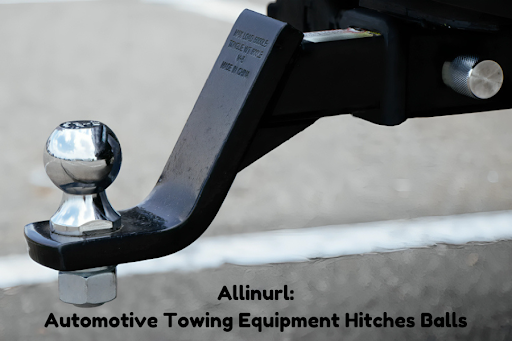The Whole Guide Allinurl: Automotive Towing Equipment Hitches Balls
When it comes to towing, having the right equipment is essential for safe and efficient hauling. Whether you’re towing a trailer for a weekend trip or transporting a vehicle across the country, understanding automotive towing equipment is key. With so many options available, it’s easy to feel overwhelmed. Allinurl: Automotive Towing Equipment Hitches Balls This guide simplifies the process, focusing on the essential components hitches and balls and how they work together to ensure a smooth towing experience. Keep reading to learn how to select the best towing equipment and make your hauling experience stress-free and safe.
Introduction: Making Towing Easy and Safe
Allinurl: Automotive Towing Equipment Hitches Balls Are you preparing to tow something but aren’t sure which equipment is right for the job? Welcome to the world of automotive towing equipment, focusing on hitches and balls the essential tools needed to safely connect your vehicle to whatever you need to haul. This guide covers everything you need to know about towing equipment, providing tips for both beginners and seasoned professionals. From understanding the basics of hitches and towing balls to selecting the ideal setup for your needs, we’ll walk you through the process.
What Is Automotive Towing Equipment?
Towing equipment refers to the collection of tools and hardware necessary to connect your vehicle to whatever you’re hauling. Among the most important components in any towing setup are:
- Hitches: The attachment point on your vehicle.
- Towing Balls: The round component that fits into the hitch and holds the trailer securely.
These two elements work in tandem to ensure a secure connection, making towing both safe and efficient. Whether you’re pulling a small utility trailer or a large RV, understanding these basic components is crucial for safe towing.
Types of Towing Hitches
Selecting the right towing hitch is crucial to ensure the safety and efficiency of your towing operation. Here’s an overview of the most common types of hitches, and what each one is best suited for:
Receiver Hitches
- Best For: Everyday towing needs such as small trailers, boats, or other light-duty items.
- Features: These hitches consist of a square receiver tube where various towing balls can be attached. Receiver hitches are available in different classes, from Class I (for light-duty towing) to Class V (for heavy-duty towing).
Fifth Wheel Hitches
- Best For: Towing large RVs or heavy-duty loads.
- Features: Installed in the truck bed, these hitches offer greater stability and weight distribution. They provide a smoother towing experience, making them ideal for long-distance hauls.
Gooseneck Hitches
- Best For: Heavy commercial towing and agriculture-related tasks.
- Features: Gooseneck hitches are similar to fifth wheels but designed for smaller spaces. They are commonly used in agricultural and industrial environments and are known for their ruggedness.
Bumper Hitches
- Best For: Light towing tasks, like bike racks or small cargo carriers.
- Features: These hitches are mounted on the bumper of your vehicle. They are easy to install and are perfect for light-duty tasks but have limited towing capacity.
Pintle Hitches
- Best For: Off-road and industrial towing, especially in rugged terrains.
- Features: Pintle hitches feature a hook-and-loop mechanism, allowing for more articulation and movement. They’re known for their durability, making them ideal for tough towing conditions.
Choosing the Right Towing Ball
Towing balls, also known as hitch balls, are available in various sizes and weight capacities. Allinurl: Automotive Towing Equipment Hitches Balls Choosing the correct size and weight rating for your towing needs is essential to ensure a safe and secure connection.
Towing Ball Sizes:
- 1 7/8 Inches: Ideal for light loads and smaller trailers.
- 2 Inches: The most common size, suitable for general towing purposes.
- 2 5/16 Inches: Designed for heavy loads such as campers, large trailers, or heavy equipment.
Towing Ball Weight Capacities:
When selecting a towing ball, always match its weight rating to the load you plan to tow:
- Light-Duty: Up to 2,000 pounds.
- Medium-Duty: Between 3,500 and 5,000 pounds.
- Heavy-Duty: Over 10,000 pounds.
Choosing a ball that is too small for the weight of your trailer can lead to dangerous towing situations, including the risk of the trailer detaching.
Additional Towing Equipment You Might Need
Beyond the essential hitches and towing balls, several other items can enhance the safety and performance of your towing setup:
- Safety Chains: Safety chains provide an additional layer of security by creating a backup connection between your trailer and your vehicle. These are crucial in case the primary connection fails.
- Weight Distribution Systems: These systems help distribute the weight of the load evenly across the vehicle’s axles, providing better stability and reducing the risk of trailer sway.
- Trailer Brakes: When towing heavier loads, trailer brakes are a must. These connect to your vehicle’s braking system and help ensure that the trailer stops in coordination with the vehicle.
- Wiring Harnesses: Wiring harnesses allow your vehicle’s lights to communicate with the trailer’s lights, ensuring that signals such as brake lights, turn signals, and running lights are synchronized.
Tips for Safe Towing
To ensure a safe and smooth towing experience, follow these essential tips:
- Match Your Equipment: Always ensure that the hitch and towing ball are compatible with your vehicle and the load you’re towing.
- Know Your Vehicle’s Towing Capacity: Before you start towing, check your vehicle’s maximum towing capacity. Overloading your vehicle can cause significant damage and increase the risk of an accident.
- Inspect Your Equipment: Always check your hitches and towing balls for any wear and tear before each use. Regular maintenance can prevent unexpected failures during towing.
- Use Safety Chains: Safety chains are a lifesaver in case your primary towing connection breaks. Make sure they are properly secured.
- Distribute the Load Evenly: Improper weight distribution can lead to trailer sway, especially at higher speeds. Balance the load properly to minimize the risk.
- Practice Towing: Towing changes the handling of your vehicle. If you’re new to towing, practice driving with a trailer in a safe, open space before heading out on the road.
Common Mistakes to Avoid When Towing
Even experienced towers can make mistakes. Avoid these common errors to ensure a smooth towing experience:
- Using the Wrong Hitch Size: Always double-check the specifications of your hitch and towing ball to make sure they’re compatible with your vehicle and trailer.
- Skipping Safety Chains: Never overlook safety chains; they could save your life in the event of a towing failure.
- Ignoring Regular Maintenance: Rust, corrosion, and general wear-and-tear can damage your towing equipment, leading to dangerous situations. Always inspect your equipment before every trip.
- Not Understanding Towing Laws: Different states and regions have varying regulations for towing, including speed limits, weight restrictions, and required equipment. Familiarize yourself with the local laws to stay compliant.
Why Proper Towing Equipment Matters
Investing in the right Allinurl: Automotive Towing Equipment Hitches Balls specifically hitches and towing balls ensures a smoother, safer journey. Whether you’re towing for business or leisure, the right setup not only saves you time but also gives you peace of mind. By selecting high-quality equipment that’s properly matched to your vehicle and load, you can avoid accidents, prevent equipment damage, and enjoy a hassle-free towing experience.
Conclusion
In conclusion, selecting the proper Allinurl: Automotive Towing Equipment Hitches Balls, specifically the right hitches and towing balls, is crucial for ensuring a safe and efficient towing experience. The right setup not only makes hauling easier but also reduces the risks associated with improper towing. Whether you’re transporting light loads or handling heavy-duty towing, knowing the types of hitches and the appropriate towing balls can significantly enhance your safety on the road.
When you match your vehicle’s towing capacity with the right equipment and regularly inspect your setup, you can avoid unnecessary accidents, ensure smooth towing, and prolong the lifespan of your Allinurl: Automotive Towing Equipment Hitches Balls. By investing in quality hitches, towing balls, and additional safety accessories like safety chains and weight distribution systems, you’ll enjoy a stress-free and reliable towing experience.
With this guide, you now have the knowledge to choose the right towing equipment for your needs. Whether you’re a first-time tower or an experienced pro, understanding the ins and outs of towing equipment will help you make informed decisions and stay safe on your journeys.
FAQs:
1. What is the most common type of towing hitch used for light-duty towing?
The most common type of towing hitch for light-duty towing is the Receiver Hitch. Allinurl: Automotive Towing Equipment Hitches Balls It’s versatile, easy to install, and supports a wide range of towing balls, making it perfect for towing small trailers, boats, or other light loads.
2. How do I know which towing ball size is right for my trailer?
To choose the correct towing ball size, first check the size of the coupler on your trailer. Common sizes include:
- 1 7/8 inches for light loads.
- 2 inches for general towing tasks.
- 2 5/16 inches for heavier loads like campers or larger trailers.
Ensure that the towing ball is rated for the weight of your load to ensure safety.
3. Can I use the same towing ball for different types of trailers?
It’s important to match the towing ball with the trailer’s coupler size and weight requirements. While some towing balls are adjustable, it’s best to use the right size and weight capacity for each specific load to ensure stability and safety.
4. Do I need a weight distribution system for all towing setups?
Weight distribution systems are primarily necessary for heavier loads, especially when towing large trailers or RVs. Allinurl: Automotive Towing Equipment Hitches Balls These systems help distribute the weight evenly across the axles of both the trailer and your vehicle, improving stability and reducing trailer sway.
5. What are safety chains, and why are they important?
Safety chains are an essential safety feature in any towing setup. They act as a backup connection between your trailer and your vehicle in case the primary hitch connection fails. Always secure the safety chains properly before towing to prevent accidents.
6. How often should I inspect my towing equipment?
It’s essential to inspect your towing equipment before every trip. Look for signs of wear and tear, rust, or damage to your hitches, towing balls, and safety chains. Regular maintenance will help you catch issues early and ensure that your equipment is in good working condition.
7. What is the towing capacity of my vehicle, and where can I find it?
Your vehicle’s towing capacity is the maximum weight it can safely tow. You can typically find this information in the vehicle’s owner manual or on the manufacturer’s website. Be sure to never exceed this capacity, as overloading can damage your vehicle and increase the risk of accidents.
8. Can I tow without using safety chains?
No, safety chains are mandatory for towing in most regions and should never be skipped. They provide an added layer of security, ensuring that if the main connection fails, your trailer will remain attached to your vehicle.
9. What is the difference between a gooseneck hitch and a fifth-wheel hitch?
Both gooseneck and fifth-wheel hitches are designed for heavy-duty towing, typically used for RVs and large trailers. Allinurl: Automotive Towing Equipment Hitches Balls A fifth-wheel hitch is installed in the truck bed and offers greater stability and weight distribution, while a gooseneck hitch is often used in smaller truck beds and offers flexibility for commercial and agricultural towing.
10. Are there towing laws I need to be aware of?
Yes, towing laws vary by state and region. Common regulations include speed limits, required safety equipment, and maximum trailer weight. Always check local laws before towing to ensure compliance and avoid fines or accidents.
Stay in the loop! We’ll keep you posted with alerts and news: Atfboru!





